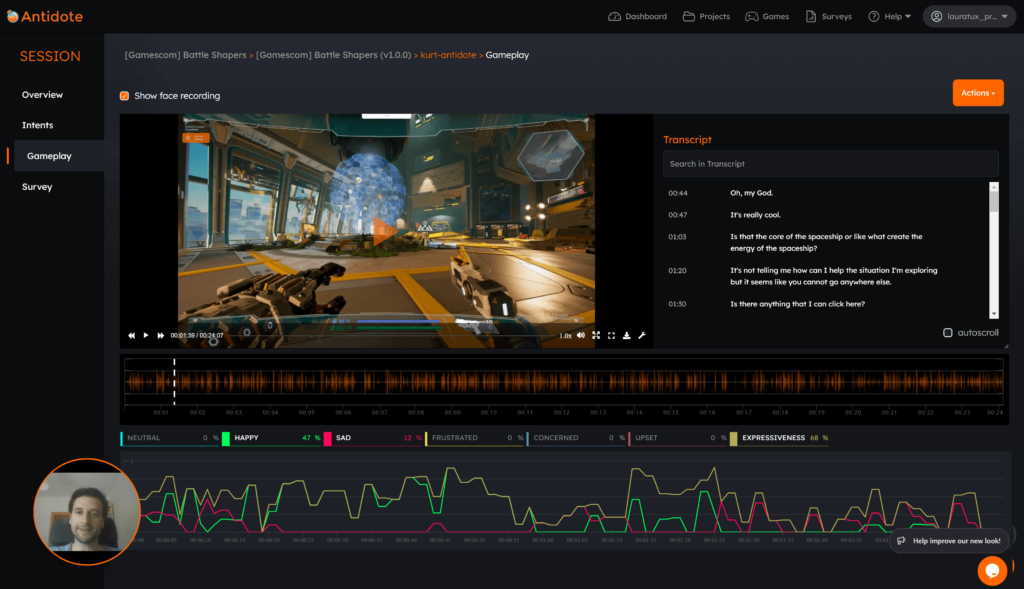I was talking to a UX researcher recently who said:
“We’ve always done our playtesting in the lab. It’s just how we’ve always done it.”
That phrase made me pause because limiting yourself to only one research method can seriously restrict what you learn about your players.
Your players aren’t going to experience your game in a sterile lab with someone watching over their shoulder. They’re going to play on their couch, during lunch breaks or on their commute.
Here are the 6 main reasons why remote playtesting should be part of your research toolkit:
Cost Efficiency

Traditional lab testing is expensive.
You need dedicated space, equipment, scheduling coordinators, and often travel costs. Those expenses add up quickly, especially if you want to test frequently throughout development.
Remote playtesting flips this equation. Participants use their own devices and spaces, often on their own schedules. You eliminate facility costs, reduce coordination overhead and can test with larger sample sizes for the same budget.
I’m not saying that the cost of remote testing is close to zero. You still need to compensate participants and invest in good research tools. But the cost per insight is often significantly lower, which means you can afford to test more frequently and with more diverse groups.
No Geographic Barriers
With in-person tests, you’re limited to whoever can physically show up to your location. If you’re in San Francisco, you’re testing with Bay Area residents. But what if your target audience lives in different continents or time zones?
Remote playtesting eliminates this constraint entirely. You can:
- Recruit that ideal player persona regardless of where they live
- Test with actual users in emerging markets
- Discover cultural differences in how players interpret game mechanics that would be impossible to capture locally.
Honestly, the world is your oyster.
Natural Player Behavior

Being watched changes how people behave.
In labs, participants often try to be “good” test subjects, overthinking decisions or trying to please researchers by finding problems that aren’t really problems.
The actual gameplay gets affected too. Players might hesitate before pressing buttons, second-guess their instincts, or take longer to make decisions because they feel pressure to explain their choices.
This isn’t how they’d naturally play your game.
Remote testing reduces this observer effect. Players are in their comfort zones, acting naturally, and often forgetting they’re being studied. The feedback tends to be more authentic, especially for emotional responses to challenging gameplay that might be very different when someone’s taking notes three feet away.
Real-World Context
Lab environments in theory offer perfect testing conditions:
- Premium setups
- Zero distractions
- Close observation
That’s not reality for most players who game on cracked phone screens in noisy coffee shops or at home in their pyjamas.
Remote playtesting shows you how your game actually performs in these real-world conditions. And this information can be extremely valuable because that’s exactly how these players will interact with your game on launch day.
Scale and Speed

The typical in-person playtest can range anywhere between 5-20 participants. Usually no more than that due to logistical complexity.
But what if you need hundreds of players for statistical significance or to stress-test multiplayer scenarios?
Remote playtesting lets you scale dramatically.
At Antidote, we helped studios conduct research studies with hundreds of participants. Fun fact: we once helped to host a multiplayer test that reached a peak of 10,000 concurrent players.
Now, this would have been a very expensive lab setup!
The speed advantage is equally important. Instead of weeks of scheduling, you can upload a build and start collecting feedback within days, enabling rapid iteration when you discover critical issues.
It’s a simple formula: scale + speed = more efficient testing
Remote Testing Isn't a Silver Bullet
Remote playtesting isn’t perfect and shouldn’t replace all other research methods.
Lab testing is superior when you need to observe micro-interactions, test accessibility features with specialized equipment, or when maximum security is required.
The goal is expanding your toolkit to choose the right approach for each research question. But remote playtesting should absolutely be part of your consideration when planning studies. The benefits we discussed provide insights that lab testing alone can’t deliver.
From my 10+ years in the gaming and user research space, I know that the most successful studios use both methods strategically.
If you’ve been hesitant to try remote playtesting, start small.
Run a pilot study alongside your next lab test and compare the insights you gather. Your players are out there experiencing games in the real world, so isn’t it time your research met them where they are?
And if you need help organizing your remote playtest, you can try the Antidote platform.
Hundreds of game studios have used it to test their builds with players worldwide. It eliminates the need for juggling dozens of different software tools while maintaining strict security measures that keep your data safe.
It’s free to try out and good luck with your playtests 😊



